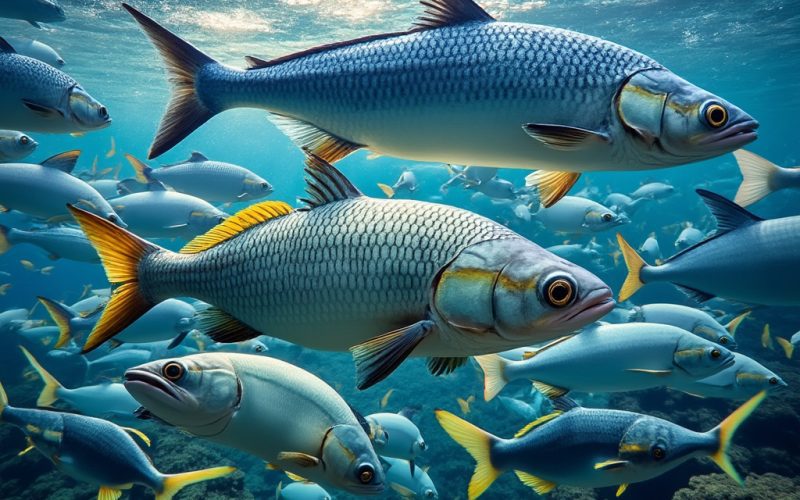
In recent years, fish farming, or aquaculture, has been heralded as a sustainable answer to the world’s growing demand for seafood. Wild fish populations decline, and since aquaculture promises a reliable, controlled source of fish that minimizes ocean impact, the choice was quickly made.
However, new findings reveal that this industry may not be as sustainable as it appears. Producing a kilogram of farmed salmon, for example, can require up to five kilograms of wild-caught fish, challenging the notion that aquaculture reduces pressure on ocean ecosystems.
Despite industry claims, it has been found that #Aquaculture has an increasing dependence on wild fish for use in feeds — https://t.co/9Ev8cqd1tt #FishFarming #SustainableSeafood
— World Fishing (@world_fishing) November 1, 2024
How Fish Farming Operates
At its core, fish farming involves raising fish species, such as salmon, in controlled environments rather than capturing them from the wild. This approach has been marketed as a way to ensure seafood supply without further depleting ocean fish stocks. But the feed required to sustain farmed fish is where the environmental impact becomes questionable.
Carnivorous farmed fish, like salmon, require a high-protein diet, often sourced from fishmeal and fish oil, which are derived from wild fish. To produce this feed, large quantities of small, wild fish are harvested, processed, and fed to farmed fish. This cycle creates a paradox: to sustain farmed fish, the industry heavily relies on the very wild fish populations it aims to protect, causing a ripple effect throughout the marine ecosystem.
To address this, some producers are turning to alternative feed solutions. A new approach involves using black soldier fly (BSF) larvae, which can be farmed sustainably by recycling organic waste. The IRD (Institut de Recherche pour le Développement) has introduced a tutorial to help people breed BSF and produce protein-rich larvae for fish, poultry, or pig feed. The IRD documentary “Sustainable Fish Farming,” available on their YouTube channel, and the accompanying “Technical Handbook of Domestication and Production of Diptera Black Soldier Fly,” guide users through rearing BSF, using organic waste as feed, and integrating larvae into animal diets. This practice offers a way to reduce the dependency on wild fish stocks, contributing to sustainable aquaculture.
Audit of the Aquaculture Industry
A recent audit of fish farming practices, led by researcher Matthew Hayek from New York University, reveals the scale of wild fish consumption within the aquaculture industry. Hayek and his team found that the amount of wild fish used to feed farmed fish is 27% to 307% higher than previously reported. This startling figure suggests that the industry’s impact on wild fish stocks is more severe than earlier assessments indicated.
The study further underscores how the industry’s demand for wild fish is affecting communities in Southeast Asia and West Africa, where fish is a staple protein. As fishmeal and fish oil demand rises, fish are increasingly diverted from local markets to industrial uses, reducing affordable access to fish for these populations. This reallocation of resources has led to an increase in malnutrition risks and economic strain on communities that depend on wild fish for their livelihoods.
The industry has tried to address this issue by exploring plant-based alternatives for fish feed. However, this shift introduces new challenges. Growing crops to feed fish increases demands on land and water, which can lead to deforestation and other environmental impacts. Furthermore, certain fish species require nutrients only available in wild fish, making plant-based diets less viable for them.
Complex Picture of Fish Farming’s Environmental and Social Costs
The audit’s conclusions paint a complex picture of fish farming’s environmental and social costs. While aquaculture may reduce some direct fishing pressures, it simultaneously generates new demands on wild fish stocks. This paradox suggests that rather than decreasing our dependence on wild fish, fish farming might be amplifying it.
Some experts suggest that a more sustainable approach would involve farming herbivorous fish species or filter-feeding shellfish like mussels and oysters, which do not require external feed inputs. These species filter nutrients from the water, contributing to marine ecosystem health while offering a seafood option with minimal environmental impact.
To improve aquaculture’s sustainability, the industry must prioritize feed efficiency, explore alternative and balanced feed sources, and reconsider the ecological impacts of farming different fish species. Without a commitment to such changes, the industry may continue to strain both the ocean’s ecosystems and the communities that rely on them.
